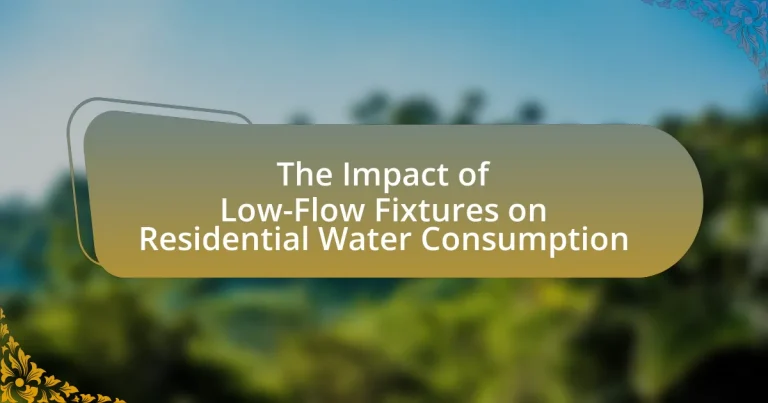Low-flow fixtures are plumbing devices designed to significantly reduce water consumption in residential settings while maintaining adequate performance. This article examines the various types of low-flow fixtures, including showerheads, faucets, and toilets, and their impact on water conservation, household water bills, and overall water usage. It highlights the technologies employed in these fixtures, their environmental benefits, and their role in sustainable water management. Additionally, the article addresses potential drawbacks, maintenance challenges, and best practices for homeowners looking to implement low-flow fixtures effectively.

What are Low-Flow Fixtures and Their Purpose?
Low-flow fixtures are plumbing devices designed to use significantly less water than standard fixtures while maintaining adequate performance. Their primary purpose is to reduce water consumption in residential settings, thereby promoting water conservation and lowering utility bills. For instance, low-flow showerheads typically use 1.5 to 2.5 gallons per minute, compared to traditional models that can use up to 5 gallons per minute. This reduction in water usage contributes to a decrease in overall household water consumption, which is crucial in areas facing water scarcity.
How do Low-Flow Fixtures differ from traditional fixtures?
Low-flow fixtures differ from traditional fixtures primarily in their water consumption efficiency. Low-flow fixtures are designed to use significantly less water, typically reducing flow rates to 1.5 gallons per minute or less, compared to traditional fixtures that often use 2.5 gallons per minute or more. This reduction in water usage leads to lower water bills and decreased demand on municipal water supplies, contributing to overall water conservation efforts. For instance, the U.S. Environmental Protection Agency estimates that replacing traditional fixtures with low-flow alternatives can save an average household up to 20,000 gallons of water annually.
What technologies are used in Low-Flow Fixtures?
Low-flow fixtures utilize technologies such as aerators, pressure-compensating valves, and dual-flush mechanisms to reduce water consumption. Aerators mix air with water, decreasing flow rates while maintaining perceived pressure, typically achieving flow rates of 1.5 gallons per minute or less. Pressure-compensating valves adjust water flow based on pressure changes, ensuring consistent performance even in varying conditions. Dual-flush mechanisms allow users to select between two flush volumes, significantly reducing water use for liquid waste. These technologies collectively contribute to a substantial decrease in residential water consumption, with studies indicating that low-flow fixtures can reduce water usage by 30% to 50% compared to standard fixtures.
How do Low-Flow Fixtures contribute to water conservation?
Low-flow fixtures contribute to water conservation by significantly reducing the amount of water used in residential settings. These fixtures, such as low-flow showerheads and faucets, are designed to limit water flow while maintaining adequate pressure, resulting in water savings of 30% to 50% compared to standard fixtures. For instance, the U.S. Environmental Protection Agency (EPA) estimates that replacing standard showerheads with low-flow models can save an average family over 2,300 gallons of water annually. This reduction not only conserves water resources but also decreases energy consumption associated with heating water, further enhancing overall sustainability.
Why are Low-Flow Fixtures important for residential water consumption?
Low-flow fixtures are important for residential water consumption because they significantly reduce water usage without sacrificing performance. These fixtures, such as low-flow showerheads and faucets, can decrease water flow rates by 30% to 50%, leading to substantial savings on water bills and conservation of a vital resource. For instance, the U.S. Environmental Protection Agency (EPA) estimates that households can save an average of 20,000 gallons of water annually by installing low-flow fixtures, which also contributes to reducing the energy required for heating water.
What impact do Low-Flow Fixtures have on household water bills?
Low-flow fixtures significantly reduce household water bills by decreasing water consumption. These fixtures, such as low-flow showerheads and faucets, can cut water usage by 20% to 60% compared to standard fixtures. For example, the U.S. Environmental Protection Agency estimates that a family can save approximately $350 annually on water bills by installing low-flow fixtures. This reduction in water usage not only lowers costs but also contributes to water conservation efforts.
How do Low-Flow Fixtures affect overall water usage in homes?
Low-flow fixtures significantly reduce overall water usage in homes by limiting the amount of water used per fixture without sacrificing performance. For instance, low-flow showerheads typically use 1.5 to 2.5 gallons per minute, compared to standard models that can use up to 5 gallons per minute. This reduction can lead to a decrease in household water consumption by 20-60%, depending on the number of fixtures installed and usage patterns. According to the U.S. Environmental Protection Agency, households can save an average of 20,000 gallons of water annually by using low-flow fixtures, demonstrating their effectiveness in promoting water conservation.

What are the Environmental Benefits of Low-Flow Fixtures?
Low-flow fixtures significantly reduce water consumption, leading to substantial environmental benefits. By using low-flow toilets, showerheads, and faucets, households can decrease their water usage by 20-60%, which conserves freshwater resources and reduces the strain on municipal water systems. This reduction in water consumption also lowers energy usage associated with water heating, contributing to decreased greenhouse gas emissions. For instance, the U.S. Environmental Protection Agency estimates that if every household in the U.S. installed water-efficient fixtures, it could save more than 3 trillion gallons of water annually, equivalent to the annual water needs of more than 30 million people.
How do Low-Flow Fixtures contribute to sustainable water management?
Low-flow fixtures significantly contribute to sustainable water management by reducing water consumption in residential settings. These fixtures, such as low-flow toilets, showerheads, and faucets, are designed to use less water while maintaining performance, often achieving reductions of 20-60% in water usage compared to standard fixtures. For instance, the U.S. Environmental Protection Agency (EPA) estimates that replacing older toilets with high-efficiency models can save an average family about 13,000 gallons of water annually. This reduction not only conserves a vital resource but also decreases the energy required for water heating and wastewater treatment, further enhancing sustainability efforts.
What role do Low-Flow Fixtures play in reducing water scarcity?
Low-flow fixtures significantly reduce water scarcity by minimizing water consumption in residential settings. These fixtures, such as low-flow showerheads and faucets, are designed to use less water while maintaining adequate pressure and performance. For instance, low-flow showerheads can reduce water usage by 40% or more compared to standard models, which translates to substantial savings in overall water consumption. According to the U.S. Environmental Protection Agency, widespread adoption of low-flow fixtures could save approximately 3 trillion gallons of water annually in the United States alone. This reduction in water usage directly contributes to alleviating water scarcity issues by conserving a vital resource and promoting sustainable water management practices.
How do Low-Flow Fixtures impact local ecosystems?
Low-flow fixtures positively impact local ecosystems by reducing water consumption, which helps maintain natural water levels in rivers, lakes, and aquifers. This conservation of water resources supports aquatic habitats and biodiversity, as lower water extraction minimizes the risk of habitat degradation and ensures that ecosystems remain balanced. For instance, a study by the U.S. Environmental Protection Agency indicates that widespread adoption of low-flow fixtures can lead to a reduction in residential water use by up to 30%, thereby alleviating pressure on local water bodies and promoting healthier ecosystems.
What are the potential drawbacks of Low-Flow Fixtures?
Low-flow fixtures can lead to inadequate water pressure, resulting in unsatisfactory performance during use. This can manifest as weak showers or slow-filling toilets, which may frustrate users and lead to decreased satisfaction with plumbing systems. Additionally, low-flow fixtures may require more time to achieve desired results, such as filling a bathtub or washing dishes, potentially leading to increased water usage in some cases. Furthermore, the initial installation costs can be higher than traditional fixtures, which may deter homeowners from making the switch despite long-term savings on water bills.
How can Low-Flow Fixtures affect water pressure and flow rate?
Low-flow fixtures can reduce water pressure and flow rate by limiting the volume of water that can pass through them. These fixtures, designed to conserve water, typically use aerators or flow restrictors to decrease the amount of water used per minute. For example, a standard showerhead may flow at 2.5 gallons per minute (GPM), while a low-flow showerhead may only flow at 1.5 GPM. This reduction in flow can lead to lower water pressure, especially in systems with existing pressure issues. Additionally, if the plumbing infrastructure is not designed to accommodate low-flow fixtures, users may experience inadequate water pressure and flow rate, impacting the overall performance of the fixtures.
What maintenance challenges are associated with Low-Flow Fixtures?
Low-flow fixtures present several maintenance challenges, primarily due to their design aimed at conserving water. These fixtures often experience clogs more frequently than traditional fixtures because the reduced water flow can fail to flush away debris effectively. Additionally, mineral buildup from hard water can accumulate in aerators and showerheads, leading to decreased performance and requiring regular cleaning or replacement. Furthermore, low-flow toilets may have issues with incomplete flushing, necessitating adjustments or repairs to ensure proper function. These challenges highlight the need for more frequent maintenance to maintain efficiency and performance in low-flow fixtures.

How can homeowners effectively implement Low-Flow Fixtures?
Homeowners can effectively implement low-flow fixtures by replacing existing faucets, showerheads, and toilets with models specifically designed to reduce water usage. For instance, low-flow showerheads typically use 1.5 to 2.5 gallons per minute, compared to standard models that can use up to 5 gallons per minute. Additionally, dual-flush toilets allow users to choose between a low-volume flush for liquid waste and a higher volume for solid waste, significantly reducing overall water consumption. According to the U.S. Environmental Protection Agency, using water-efficient fixtures can save an average family about 20% on their water bill, translating to approximately 13,000 gallons of water annually.
What types of Low-Flow Fixtures are available for residential use?
Low-flow fixtures available for residential use include low-flow toilets, low-flow showerheads, and low-flow faucets. Low-flow toilets typically use 1.28 gallons per flush or less, significantly reducing water consumption compared to standard models that use 1.6 gallons or more. Low-flow showerheads are designed to use 2.5 gallons per minute or less, while traditional showerheads can use up to 5 gallons per minute. Low-flow faucets generally have flow rates of 1.5 gallons per minute or less, compared to standard faucets that can flow at 2.2 gallons per minute or higher. These fixtures collectively contribute to substantial water savings in residential settings, aligning with water conservation efforts.
Which Low-Flow Fixtures are most effective for bathrooms?
Low-flow fixtures that are most effective for bathrooms include low-flow toilets, low-flow showerheads, and faucet aerators. Low-flow toilets use 1.28 gallons per flush or less, significantly reducing water usage compared to standard toilets that use 1.6 gallons or more. Low-flow showerheads typically use 2.0 gallons per minute or less, which can save up to 40% of water compared to traditional models. Faucet aerators can reduce flow rates to 1.5 gallons per minute or less, contributing to overall water conservation. These fixtures collectively can lead to substantial reductions in residential water consumption, with studies indicating that households can save an average of 20-30% on water bills by implementing these low-flow options.
What Low-Flow options are best for kitchens and laundry rooms?
Low-flow options that are best for kitchens and laundry rooms include low-flow faucets, aerators, and high-efficiency washing machines. Low-flow faucets typically use 1.5 to 2.2 gallons per minute (GPM), significantly reducing water usage compared to standard faucets that use 2.2 GPM or more. Aerators can be added to existing faucets to further decrease flow rates without sacrificing performance, often reducing flow to 1.0 GPM. High-efficiency washing machines use approximately 15 gallons per load, compared to older models that can use up to 40 gallons, resulting in substantial water savings. These fixtures collectively contribute to lower residential water consumption, aligning with sustainability goals and reducing utility costs.
What best practices should homeowners follow when installing Low-Flow Fixtures?
Homeowners should prioritize proper sizing and compatibility when installing low-flow fixtures to ensure optimal performance and water savings. Selecting fixtures that match existing plumbing systems and water pressure is crucial; for instance, low-flow showerheads should be compatible with the home’s water pressure to avoid inadequate flow rates. Additionally, homeowners should follow manufacturer installation guidelines meticulously, as improper installation can lead to leaks or reduced efficiency.
Research indicates that low-flow fixtures can reduce water usage by 20-60%, depending on the type and application, which underscores the importance of correct installation for maximizing these benefits. Regular maintenance checks are also recommended to ensure that fixtures remain in good working order and continue to operate efficiently over time.
How can homeowners ensure proper installation of Low-Flow Fixtures?
Homeowners can ensure proper installation of low-flow fixtures by following manufacturer guidelines and hiring qualified professionals for installation. Adhering to the specific instructions provided by the manufacturer guarantees that the fixtures operate efficiently and effectively, as these guidelines are designed based on the product’s engineering specifications. Additionally, employing licensed plumbers who are experienced with low-flow technology can help avoid common installation errors, ensuring that the fixtures are correctly fitted and function as intended. Proper installation can lead to significant water savings, with studies indicating that low-flow fixtures can reduce water usage by 20-60%, depending on the type of fixture and household habits.
What tips can help maximize the efficiency of Low-Flow Fixtures?
To maximize the efficiency of low-flow fixtures, regular maintenance and proper installation are essential. Ensuring that fixtures are installed according to manufacturer specifications prevents leaks and optimizes water flow. Additionally, cleaning aerators and showerheads periodically removes mineral buildup, which can impede water flow and reduce efficiency. Using low-flow fixtures in conjunction with water-efficient appliances, such as dual-flush toilets and Energy Star-rated dishwashers, further enhances overall water savings. Studies indicate that households can reduce water consumption by 30% or more by implementing these strategies, demonstrating the significant impact of low-flow fixtures on residential water usage.
What are common misconceptions about Low-Flow Fixtures?
Common misconceptions about low-flow fixtures include the belief that they significantly reduce water pressure and that they are ineffective in providing adequate performance. In reality, modern low-flow fixtures are designed to maintain water pressure while using less water, often achieving performance levels comparable to traditional fixtures. For example, the U.S. Environmental Protection Agency (EPA) states that low-flow showerheads can save up to 2.5 gallons of water per minute without sacrificing water pressure. Additionally, many consumers mistakenly think that low-flow fixtures are only suitable for new constructions, but they can be easily retrofitted into existing homes, making them accessible for widespread use.
Do Low-Flow Fixtures compromise water quality or performance?
Low-flow fixtures do not compromise water quality or performance when designed and installed correctly. Research indicates that modern low-flow fixtures, such as faucets and showerheads, can maintain adequate water pressure and flow rates while significantly reducing water usage. For instance, the U.S. Environmental Protection Agency (EPA) states that low-flow showerheads can use as little as 2.0 gallons per minute compared to traditional models that use 2.5 gallons per minute or more, without sacrificing performance. Additionally, studies show that these fixtures can effectively deliver the necessary water for daily activities, ensuring both efficiency and user satisfaction.
Are Low-Flow Fixtures more expensive than traditional fixtures?
Low-flow fixtures are generally more expensive than traditional fixtures. The initial cost of low-flow fixtures can be higher due to advanced technology and materials designed to reduce water usage. For example, a study by the American Society of Plumbing Engineers found that while low-flow toilets can cost 20-30% more upfront, they save homeowners significant amounts on water bills over time, often recouping the initial investment within a few years.


